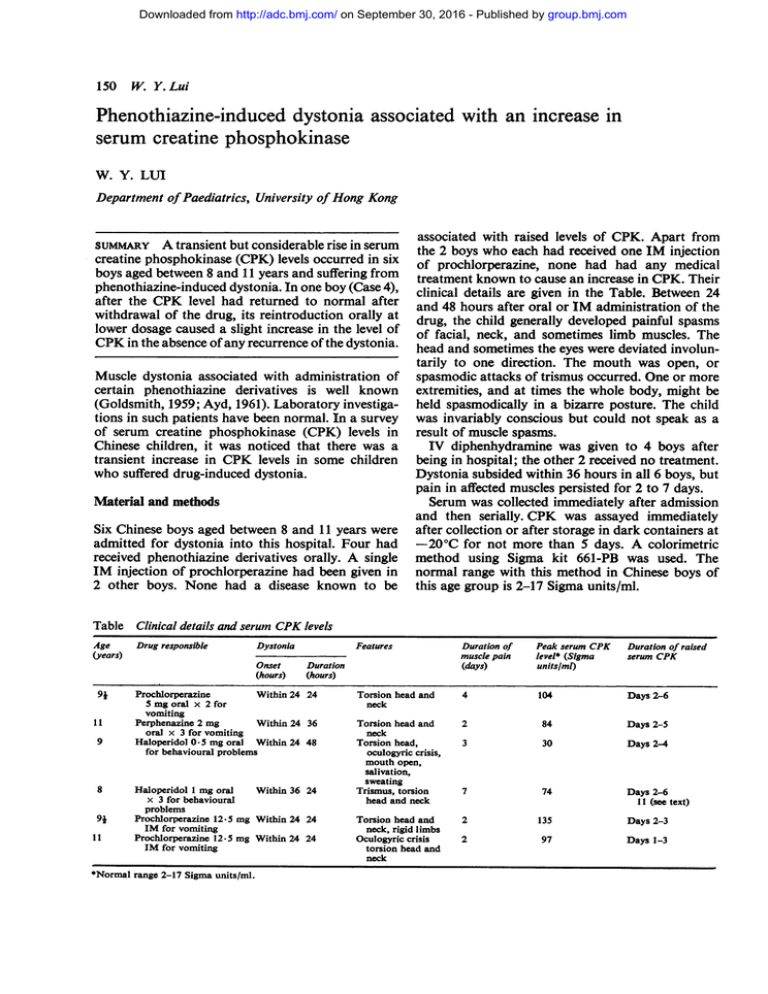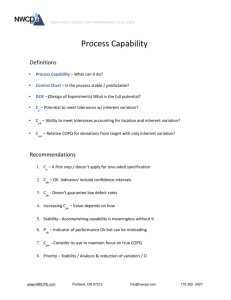Phenothiazine-induced dystonia associated with an increase in
advertisement

Downloaded from http://adc.bmj.com/ on September 30, 2016 - Published by group.bmj.com 150 W. Y. Lui Phenothiazine-induced dystonia associated with serum creatine phosphokinase an increase in W. Y. LUI Department of Paediatrics, University of Hong Kong associated with raised levels of CPK. Apart from the 2 boys who each had received one TM injection of prochlorperazine, none had had any medical treatment known to cause an increase in CPK. Their clinical details are given in the Table. Between 24 and 48 hours after oral or TM administration of the drug, the child generally developed painful spasms of facial, neck, and sometimes limb muscles. The head and sometimes the eyes were deviated involuntarily to one direction. The mouth was open, or Muscle dystonia associated with administration of spasmodic attacks of trismus occurred. One or more certain phenothiazine derivatives is well known extremities, and at times the whole body, might be (Goldsmith, 1959; Ayd, 1961). Laboratory investiga- held spasmodically in a bizarre posture. The child tions in such patients have been normal. In a survey was invariably conscious but could not speak as a of serum creatine phosphokinase (CPK) levels in result of muscle spasms. Chinese children, it was noticed that there was a TV diphenhydramine was given to 4 boys after transient increase in CPK levels in some children being in hospital; the other 2 received no treatment. who suffered drug-induced dystonia. Dystonia subsided within 36 hours in all 6 boys, but pain in affected muscles persisted for 2 to 7 days. Material and methods Serum was collected immediately after admission and then serially. CPK was assayed immediately Six Chinese boys aged between 8 and 11 years were after collection or after storage in dark containers at admitted for dystonia into this hospital. Four had -20°C for not more than 5 days. A colorimetric received phenothiazine derivatives orally. A single method using Sigma kit 661-PB was used. The TM injection of prochlorperazine had been given in normal range with this method in Chinese boys of 2 other boys. None had a disease known to be this age group is 2-17 Sigma units/ml. suMMARY A transient but considerable rise in serum creatine phosphokinase (CPK) levels occurred in six boys aged between 8 and 11 years and suffering from phenothiazine-induced dystonia. In one boy (Case 4), after the CPK level had returned to normal after withdrawal of the drug, its reintroduction orally at lower dosage caused a slight increase in the level of CPK in the absence of any recurrence of the dystonia. Table Clinical details and serum CPK levels Age (years) Drug responsible Dystonia Onset (hours) 9i 11 9 8 9j 11 Peak serum CPK level* (Sigma Torsion head and neck 4 104 Days 2-6 Torsion head and neck Torsion head, oculogyric crisis, mouth open, 2 84 Days 2-5 3 30 Days 2-4 salivation, sweating Trismus, torsion head and neck 7 74 Days 2-6 11 (see text) Torsion head and neck, rigid limbs Oculogyric crisis torsion head and neck 2 135 Days 2-3 2 97 Days 1-3 (hours) Prochlorperazine Within 24 24 5 mg oral x 2 for vomiting Perphenazine 2 mg Within 24 36 oral x 3 for vomiting Haloperidol 0-5 mg oral Within 24 48 for behavioural problems Haloperidol 1 mg oral Within 36 24 x 3 for behavioural problems Prochlorperazine 12-5 mg Within 24 24 IM for vomiting Prochlorperazine 12.5 mg Within 24 24 IM for vomiting *Normal range 2-17 Sigma units/ml. Duration of muscle pain (days) Features Duration Duration of raised serum CPK units/ml) Downloaded from http://adc.bmj.com/ on September 30, 2016 - Published by group.bmj.com Phenothiazine-induced dystonia associated with an increase in serum creatine phosphokinase 151 rigidity (Okinaka et al., 1964), its increase in patients suffering from drug-induced dystonia was not In all 6 boys, serum CPK was abnormally high, reported. With severe muscle dystonia, this enzyme reaching a peak level between 2 and 4 days after the may perhaps be released into the circulation. onset of dystonia. Thereafter the levels dropped to Previous reports on phenothiazine-induced dystonia normal within a week. The peak levels reached found no correlation between the dosage or route of ranged from 30 to 135 Sigma units/ml. administration of the drug, and the occurrence and In one 8-year-old boy (Case 4), in whom dystonia severity of dystonia (Goldsmith, 1959). It is notable had been induced by three oral 1 mg doses of however that in our Case 4 the CPK level rose again haloperidol given within a day (for psychiatric on reintroducing the drug at a lower dosage but did symptoms), the peak CPK level was 74 Sigma units/ not cause dystonia or muscle pain. This raises the ml. After withdrawal of haloperidol, the level fell to possibility that the offending drug at a lower dosage 9 Sigma units/ml in a week. Three days after reintro- may lead to subclinical disturbances of muscle ducing the drug at 0 5 mg twice a day, his CPK function. level rose to 19 Sigma units/ml, but without any recurrence either of muscle pain or dystonia. References Results Discussion Raised levels of serum CPK have been known to be associated with active progressive muscular dystrophy, acute polymyositis, periodic paralysis, repeated intramuscular infections, strenuous exercise, myocardial infarction, and cardiac catheterisation, and also with the immediate newborn period. Although increased levels of CPK have been reported in patients with Wilson's disease who had marked Ayd, F. J., Jr (1961). A survey of drug-induced extrapyramidal reactions. Journal of the American Medical Association, 175, 1054-1060. Goldsmith, R. W. (1959). Toxicity of phenothiazine compounds. Pediatrics, 23, 1015-IC16. Okinaka, S., Sugita, H., Momoi, H., Toyokura, Y., Watanabe, T., Ebashi, F., and Ebashi, S. (1964). Cysteinestimulated serum creatine kinase in health and disease. Journal of Laboratory and Clinical Medicine, 64, 299-305. Correspondence to Dr W. Y. Lui, Department of Paediatrics, Queen Mary Hospital, Hong Kong. Downloaded from http://adc.bmj.com/ on September 30, 2016 - Published by group.bmj.com Phenothiazine-induced dystonia associated with an increase in serum creatine phosphokinase. W Y Lui Arch Dis Child 1979 54: 150-151 doi: 10.1136/adc.54.2.150 Updated information and services can be found at: http://adc.bmj.com/content/54/2/150 These include: Email alerting service Receive free email alerts when new articles cite this article. Sign up in the box at the top right corner of the online article. Notes To request permissions go to: http://group.bmj.com/group/rights-licensing/permissions To order reprints go to: http://journals.bmj.com/cgi/reprintform To subscribe to BMJ go to: http://group.bmj.com/subscribe/




